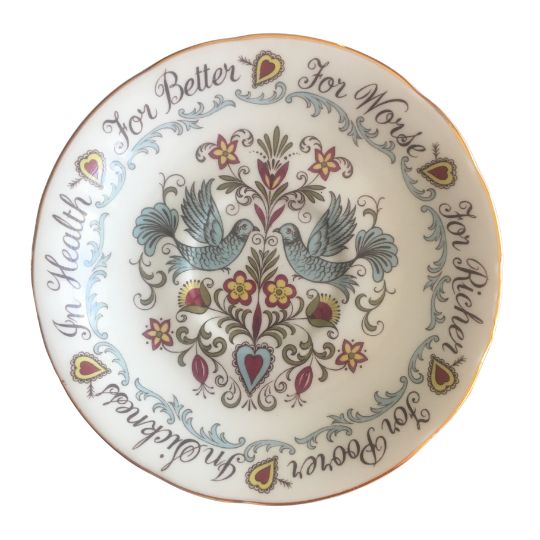The Traditional Wedding
Vows
/08
by Jennifer
Cram - Brisbane Marriage Celebrant © (09/05/2023)
Categories: | Vows | Wedding Legals |
 For Better. For Worse.
For Richer. For Poorer. Possibly some of the
most familiar words in the English language.
The "traditional wedding vows".
For Better. For Worse.
For Richer. For Poorer. Possibly some of the
most familiar words in the English language.
The "traditional wedding vows".These words have been said by millions, hundreds of millions of marrying couples since they were first included in the religious rite of marriage 500 or so years ago. With slight tweaks over the years to reflect changes in the English language and in social norms, they been said in religious and secular weddings, by real marrying couples, and by actors in stage and screen.
There is nothing wrong with them! For many people, their familiarity appeals. They cover the bases in succinct, simple words. In fact, a large part of their power lies in their simplicity. And in the fact that, with the exception of the promise to love, every single thing that they promise is an observable behaviour. Something that can be seen to be done.
They can also serve as a template for a more personal expression of your commitment to how you will behave towards one another in your marriage.
Using
the
Traditional
Vows as a
Template
Add
How
would you use the traditional vows as a
template for your personal vows?
Using
the
Traditional
Vows as a
Template
Rewrite the traditional vows in your own words. Personalise with examples of what is important in your own relationship, how you will demonstrate your love. How you will cherish one another in practical terms.
The
Legal Bits
Add
The
(Australian) Marriage Act specifies that
each of you must say to the other
The
Legal Bits
It you are being married outside a church
ceremony, therefore, by a civil celebrant or
in the Registry Office or at a courthouse,
you must say this, which means you can't use
the first line of the traditional vows,
which is
I, (First name), take you (First name)
to be my wedded wife/husband
But, as you might notice,
those words are the core of the legal vows
that we say in civil ceremonies. And there
is a good reason for this.
A
little bit of
history
Add
History explains why
the legal vows that must be said in Australia
to create your marriage are so similar to the
first line of the traditional vows, the legal
vows said in English speaking countries
everywhere, and to the first line of the vows
still said in Church of England ceremonies. It
all goes back to Henry VIII's break with Rome.
A
little bit of
history
From the time of the Reformation, the Church of England (the template used for civil marriage ceremonies which, in the Registry Office version have always been pretty well the same ceremony with the religious bits stripped out), operated under legal provisions established by the Parliament in Westminster. And the traditional marriage vows, as per the Book of Common Prayer, were part of the civil laws of England. At least, until Oliver Cromwell abolished them and substituted a system of civil marriages (An Act touching Marriages and the Registering thereof; and also touching Births and Burials,1653).
Under Cromwell's Act
- The couple had to appear before a Justice of the Peace to give at least 21 days notice (3 consecutive Sundays) notice of their intention to marry
- If either was under 21 they had to have parental consent
- Once the required notice period had
passed, and their intentional published on
those 3 consecutive Sundays, a certificate
of Due Performance was issued. Without
that certificate the couple could not be
married
- The wedding was in the presence of
Justice of the Peace
- The wording in the Act is:
The Man to be married, taking the Woman to be married by the hand, shall plainly and distinctly pronounce these words:
I A. B. do here in the presence of God the searcher of all hearts, take thee C. D. for my wedded Wife; and do also in the presence of God, and before these witnesses, promise to be unto thee a loving and faithful Husband.
And then the Woman, taking the Man by the hand, shall plainly and distinctly pronounce these words:
I C. D. do here in the presence of God the searcher of all hearts, take thee A. B. for my wedded Husband; and do also in the presence of God, and before these witnesses, promise to be unto thee a loving, faithful and obedient Wife.
- The Justice then had to declare them married by saying No other Marriage shall be good.
The
Puritan Legacy
in the
Traditional
Vows
Add
There are three
things that I find fascinating about the
legacy of Cromwell's short-lived marriage
reforms
The
Puritan Legacy
in the
Traditional
Vows
- The trend towards simplicity and reduced ceremonial, together with the downplaying of marriage as not a sacrament and not peculiar to the Christian Church, and therefore of universal public interest, formed the basis of the implementation of civil, registry office marriages as we know them today.
- Likewise, the conducting of marriage ceremonies by persons not ordained as clergy, a feature of registry office marriages, has continued with the implementation of the civil celebrant program in Australia and the push for independent marriage celebrants to be authorised to solemnise legal marriage in England in Wales.
- While, post Restoration, the Church of
England dispensed with the Puritan,
Scots-Presbyterian influenced alternative
vows of Cromwell's Marriage Act, in
reverting to the previous version of the
vows it retained one thing. The
requirement of the bride to promise to
obey. And it wasn't until relatively
recently that most Christian religions,
fundamentalist churches being the
exception, eliminated that requirement.
Related
Information
Add
Related
Information
Thanks for reading!

pullin0 Thingsriin